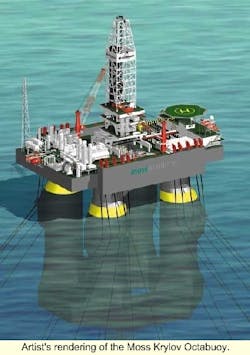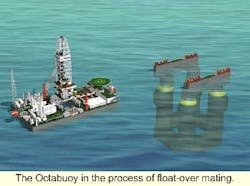DRILLING RIG TECHNOLOGY: Semisubmersible drilling design minimizes heave, pitch, and roll
Judy Maksoud
International Editor
Oil and gas producers have had to compromise often when choosing among available concepts for deepwater field development. In enumerating these trade- offs, engineers at Moss Maritime dev-eloped the specifications for a new semisub-mersible design they believe helps minimize the difficulties. The main objectives in developing the new design were to:
- Eliminate costly offshore installation and commissioning
- Provide topsides weight capacity and deck area for maximum flexibility
- Provide a choice of rigid or flexible risers for dry or subsea completions
- Provide good motion characteristics in the design, which together with a taut leg mooring system would keep offsets within margins comparable with tension leg platforms (TLP)
- Improve pitch and roll motions to prevent riser fatigue.
The realization of these design objectives is the Octabuoy, a semisubmersible production platform that is able to perform drilling operations, well completions, workovers, and maintenance functions. The concept, developed by Norwegian-based Moss Maritime was designed principally to suit the environmental conditions typical in West Africa, Brazil, and the Gulf of Mexico, all major targets for deepwater drilling.
Moss Maritime teamed with the Krylov Shipbuilding Research Institute in St. Petersburg to define a testing and development program to refine the hull parameters of the Octabuoy. The result is a production platform that is moored by a passive 16-20-point, taut-leg mooring system consisting of chain/fiber/chain with extremely favorable heave, pitch, and roll motions and significantly reduced offset.
Motion control
The key to the platform's motion characteristics is an accurate fine tuning of the platform's hull parameters and stability. The shape of the Octabuoy reduces the pitch and roll motions of the unit to a level that allows for the use of rigid risers and thus, dry wellheads at the main deck level.
Designers placed emphasis on eliminating 2nd order roll and pitch motions, known as the Mathieu effect. The designers say that semisubmersibles and Spars can experience this type of motion, which cannot be revealed by linear hydrodynamic calculation.
Unlike other concepts such as the Spar, the designers say the Octabuoy concept is not sensitive to heave resonance effects because of a relatively high natural period. This is important in areas such as West Africa, where wave data is dominated by swell, which produces long wave periods.
Structure
The design consists of an octagonal ring pontoon, four columns, and two deck sponsons on top of the columns, which provide for buoyancy and waterline area during mating. The lower hull height is 83 meters; the height of the pontoon is 12 meters, and the length/breadth of the pontoon is 90 meters. The deck structure is 8 meters high and has a main deck area of 6,200 sq meters with a topside weight capacity, including deck structure, of 28,000 tons.
The lower hull of the unit is used for ballast tanks, pump rooms, bulk mud, and cement tanks. It also houses tanks for fuel, drill water, potable water, mud, brine, and base oil. The main deck is arranged with quarters, heli-deck, lifeboats, a drilling unit, and process facilities. A 16-meter-by-20-meter moon pool is situated in the center.
The well bay area can accommodate 20 risers and dry trees. The motion compensation of the production risers is carried out by a top tensioning system, based on ram-style cylinders, proven components also used on TLPs. The Moss Krylov unit can accommodate a wide range of production rates and specifications and has facilities to allow operators to carry out drilling, completion, workover, and well maintenance.
Flexibility and re-use
A unique feature of the Octabuoy design is its construction path. The hull and the deck can be built and outfitted independently, which can dramatically reduce cost.
Both the hull and deck have been designed to float at less than 30 ft draft. Once completed, the barge-type deck structure can be moved to wherever process equipment and other topsides facilities are to be installed.
The lower hull can be moored and ballasted to the required mating draft, and the outfitted deck can be floated over. Connection between the substructure and deck is made before de-ballasting to operation draft.
By allowing full installation and outfitting of the deck barge equipment at quayside inshore, the Octabuoy concept can minimize or eliminate offshore installation and hook-up operations. This installation procedure can also be reversed. At the end of field life, the deck barge can be released and re-equipped to accommodate new specifications for moving into a new field.


